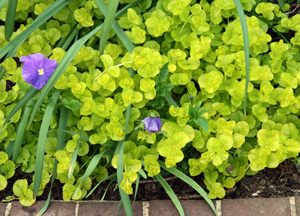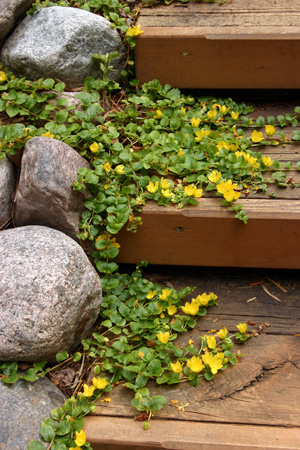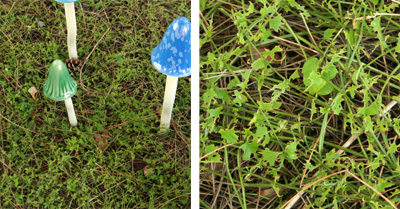
There are many species of Lysimachia that are used as ornamental plants. Golden creeping Jenny, the cultivar ‘Aurea’ of the low-growing species L. nummularia (= L. zawadzkii), can be a nice addition to containers or in other locations where its spread can be limited. This genus was traditionally placed in the primrose family (Primulaceae), and was reclassified a few years ago in the Myrsinaceae, but this family was recently redesignated as the subfamily Myrsinoideae in the Primulaceae – confused yet? – so it apparently is back where it started. This European species can be invasive (so planting the green type is not recommended), but the yellow cultivar is much less aggressive and suitable for judicious use in ornamental plantings. Other common names include moneywort, herb twopence, and occasionally creeping Charlie (not to be confused with the lawn weed Glechoma hederacea also commonly called creeping Charlie). This herbaceous perennial is hardy in zones 3-9 and was a winner of the Royal Horticultural Society Award of Merit.

The creeping plants produce small, rounded leaves with wavy edges oppositely along the thin, trailing stems. The orbicular leaves are smooth and often shiny – resembling a string of small coins – with a few glandular black dots if you look closely. The almost-evergreen foliage of the cultivar ‘Aurea’ is yellow, ranging from lime green to soft chartreuse in shade, through golden yellow in partial or dappled shade, to a brassy gold in full sun (it may burn out in more southern areas in full sun), while that of the species is a soft green.

The stems grow vigorously, forming slender fibrous roots where leaf nodes come in contact with the soil. This creates a dense mat 2-4 inches tall growing chaotically in all directions.

Single, bright yellow, cup-shaped flowers with are occasionally produced in the leaf axils. Each 1″ flower has 5 petals with dark reddish glandular dots, all set in a hairless green calyx with 5 triangular teeth shorter than the petals.


The plants bloom intermittently from early summer through fall, although this cultivar does not seem to bloom as consistently as the species (and sometimes forms just vegetative colonies that never bloom). Because the flowers are not dramatically different in color than the foliage, they are also not as conspicuous as on the green species. Seed capsules do not form readily, so ‘Aurea’ does not spread by seed as readily as the green type will.
Use golden creeping Jenny carefully, to be sure it will not escape from cultivation or crowd out other plants in the garden. It makes a nice groundcover with tulips and daffodils, filling in the space once the bulbs’ leaves die back for the season. But it can overgrow other short plants, so situate it appropriately. It makes a nice underplanting beneath roses or other shrubs and around daylilies, ferns and tall perennials.

It makes a great contrast between dark-leaved plants, such as ‘Amethyst Myst’ or ‘Palace Purple’ Heuchera, or mingling with purple ajuga. Use it as a color echo with lady’s mantle (Alchemilla mollis) or a chartreuse or golden hosta such as ‘Sun Power’ or ‘Sum and Substance’ or a chartreuse cultivar of ornamental sweet potato (Ipomoea batatas). Use golden creeping Jenny as a trailing plant in containers, window boxes, or hanging baskets, or try planting it where it can cascade over a wall or bank. It can be used in ponds, water gardens, or marginal areas along waterways (as long as there is no danger of it escaping into natural areas) in shallow (up to 2″) water where it provides habitat for frogs, insects and small fish.

L. nummularia ‘Aurea’ can be planted almost any exposure from full sun to light shade, in moist soils. For the best color, situate the plant so it receives morning sun. It is rather shallow-rooted (so is fairly easy to dig out should it move into an area where it is unwanted), and does best with regular watering. It thrives in damp soils where other ground covers often cannot survive.

Creeping Jenny has few pests, although in some places slugs may attack the leaves and nearly completely defoliate the plants when high populations are present. The plants will look unsightly but the plants will usually survive.
This plant is easily propagated by division (removing rooted chunks near the edge of a patch) or cuttings. It will readily root at nodes, so it may require persistent weeding to remove all of it from an area.
– Susan Mahr, University of Wisconsin – Madison
Ask Your Gardening Question
If you’re unable to find the information you need, please submit your gardening question here:





 ▶︎ Watch: Fall Bulb Planting
▶︎ Watch: Fall Bulb Planting Aster, Symphyotrichum spp.
Aster, Symphyotrichum spp. Fascinating Fasciation
Fascinating Fasciation Alternatives to Lawn: Groundcovers
Alternatives to Lawn: Groundcovers


